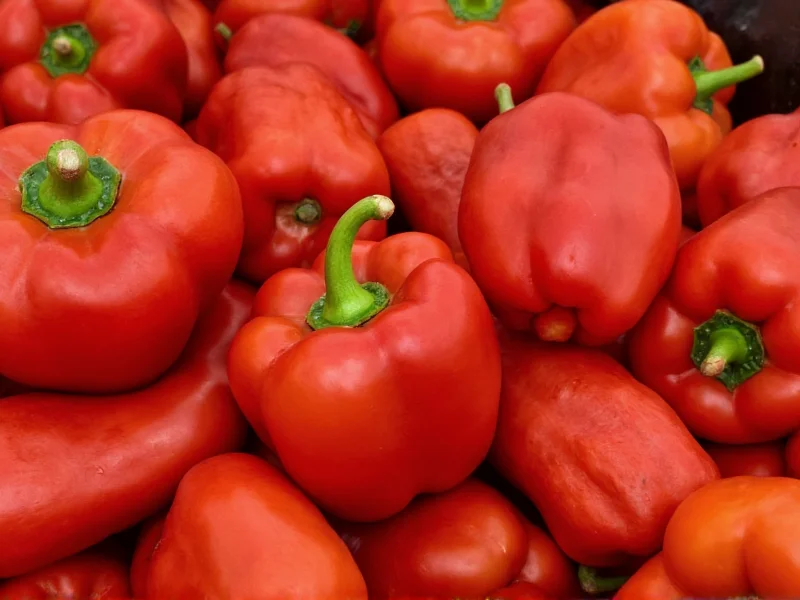Understanding pepper shelf life helps reduce food waste and ensures you enjoy these versatile vegetables at their peak freshness. Whether you've bought a bulk bag at the farmers market or received peppers from your garden, proper storage knowledge makes a significant difference in how long your peppers stay crisp and flavorful.
How Long Do Different Pepper Types Last?
Not all peppers share the same shelf life. The variety, ripeness, and storage conditions dramatically affect longevity:
| Pepper Type | Room Temperature | Refrigerated | Frozen |
|---|---|---|---|
| Bell peppers (whole) | 3-5 days | 1-2 weeks | 6-12 months |
| Bell peppers (cut) | Not recommended | 3-5 days | 6-12 months |
| Chili peppers (whole) | 2-4 days | 1-3 weeks | 6-10 months |
| Jalapeños (whole) | 3-5 days | 2-3 weeks | 6-8 months |
| Sweet banana peppers | 3-4 days | 2-3 weeks | 6-10 months |
Optimal Pepper Storage Methods
Proper storage techniques significantly extend how long peppers last before showing signs of spoilage. The crisper drawer in your refrigerator provides the ideal humidity-controlled environment for whole peppers. Store them in the high-humidity setting (closed vent) to maintain crispness.
For cut peppers, transfer them to an airtight container with a paper towel to absorb excess moisture. This simple step prevents premature softening and extends freshness by several days. Never store cut peppers uncovered in the refrigerator.
Recognizing When Peppers Have Gone Bad
Knowing how to tell if peppers have spoiled prevents food waste while ensuring safety. Fresh peppers should feel firm with smooth, taut skin. Watch for these clear indicators that peppers no longer last safely:
- Excessive softness or mushy spots
- Deep wrinkles or shriveling skin
- Visible mold in white, green, or black patches
- Slime formation on the surface
- Unpleasant or sour odor
- Discoloration beyond normal ripening
Minor surface blemishes can often be cut away, but when more than 25% shows spoilage signs, discard the entire pepper. Remember that soft spots on peppers last significantly less time than firm sections.
Maximizing Pepper Shelf Life: Practical Tips
Several science-backed methods help peppers last longer while maintaining quality. First, never wash peppers before storage—excess moisture accelerates decay. Instead, wash them just before use. Store whole peppers stem-side down to reduce moisture accumulation at the vulnerable blossom end.
For gardeners with surplus harvest, consider these preservation methods that dramatically extend how long peppers remain usable:
- Freezing: Slice or dice peppers, spread on a baking sheet, freeze until solid, then transfer to freezer bags. This flash-freezing method prevents clumping.
- Pickling: Vinegar-based pickling preserves peppers for 1-2 years while adding flavor complexity.
- Roasting and freezing: Roast peppers until blistered, peel, then freeze for future sauces and dishes.
- Drying: Use a food dehydrator or oven on lowest setting to create shelf-stable dried peppers.
Special Considerations for Different Pepper Varieties
Understanding how long specific pepper types last helps optimize your storage approach. Bell peppers with thicker walls generally outlast thinner varieties. Red and yellow bell peppers, being more ripe, typically have a shorter shelf life than green peppers.
Hot peppers like habaneros and serranos often last longer than sweet varieties due to their natural preservative compounds. When storing mixed peppers, separate hot varieties from sweet ones to prevent flavor transfer through ethylene gas.
Common Questions About Pepper Storage
Many home cooks wonder whether certain storage practices affect pepper longevity. Contrary to popular belief, storing peppers with tomatoes accelerates spoilage due to ethylene gas production. Keep them separate to maximize how long peppers last.
Another frequent question involves refrigeration timing. While some produce suffers from cold shock, peppers consistently last longer when refrigerated promptly after purchase. The exception is if you plan to use them within 24-48 hours.
How long do peppers last after cutting?
Cut peppers maintain freshness for 3-5 days when stored in an airtight container with a paper towel in the refrigerator. The exposed flesh deteriorates faster than whole peppers, so plan to use cut peppers promptly for best quality.
Can you freeze whole peppers?
Yes, you can freeze whole peppers, but they become softer when thawed. For best results, freeze peppers after roasting or blanching. Whole frozen peppers last 6-12 months while maintaining flavor, though texture changes make them better suited for cooked dishes rather than raw applications.
Why do my peppers get slimy in the refrigerator?
Peppers develop slime when excess moisture accumulates during storage. This commonly happens when peppers sweat in plastic bags or when stored near high-moisture produce. To prevent this, store peppers in perforated bags or with paper towels to absorb condensation, and avoid washing before storage.
Do peppers last longer on the counter or in the fridge?
Peppers last significantly longer in the refrigerator than on the counter. While room temperature storage works for immediate use (3-5 days), refrigeration extends pepper shelf life to 1-3 weeks depending on variety. The cooler temperature slows enzymatic decay and moisture loss that cause peppers to wrinkle and soften.
How can I tell if my peppers are still good to eat?
Fresh peppers should feel firm with smooth, taut skin and vibrant color. Discard peppers showing significant soft spots, deep wrinkles, mold, or unpleasant odors. Minor surface blemishes can be cut away, but when more than 25% shows spoilage signs, the entire pepper has passed its prime and should not be consumed.











 浙公网安备
33010002000092号
浙公网安备
33010002000092号 浙B2-20120091-4
浙B2-20120091-4